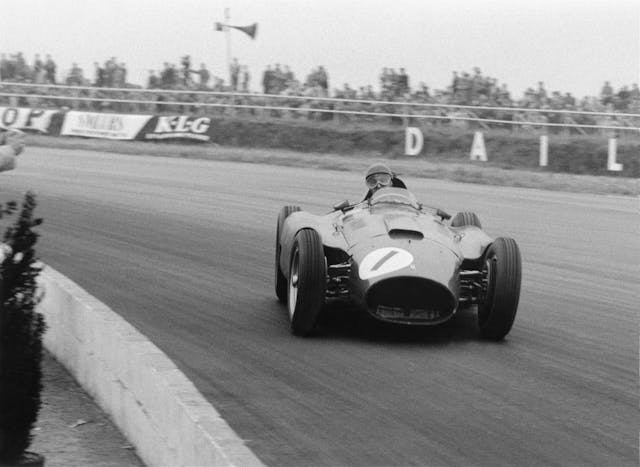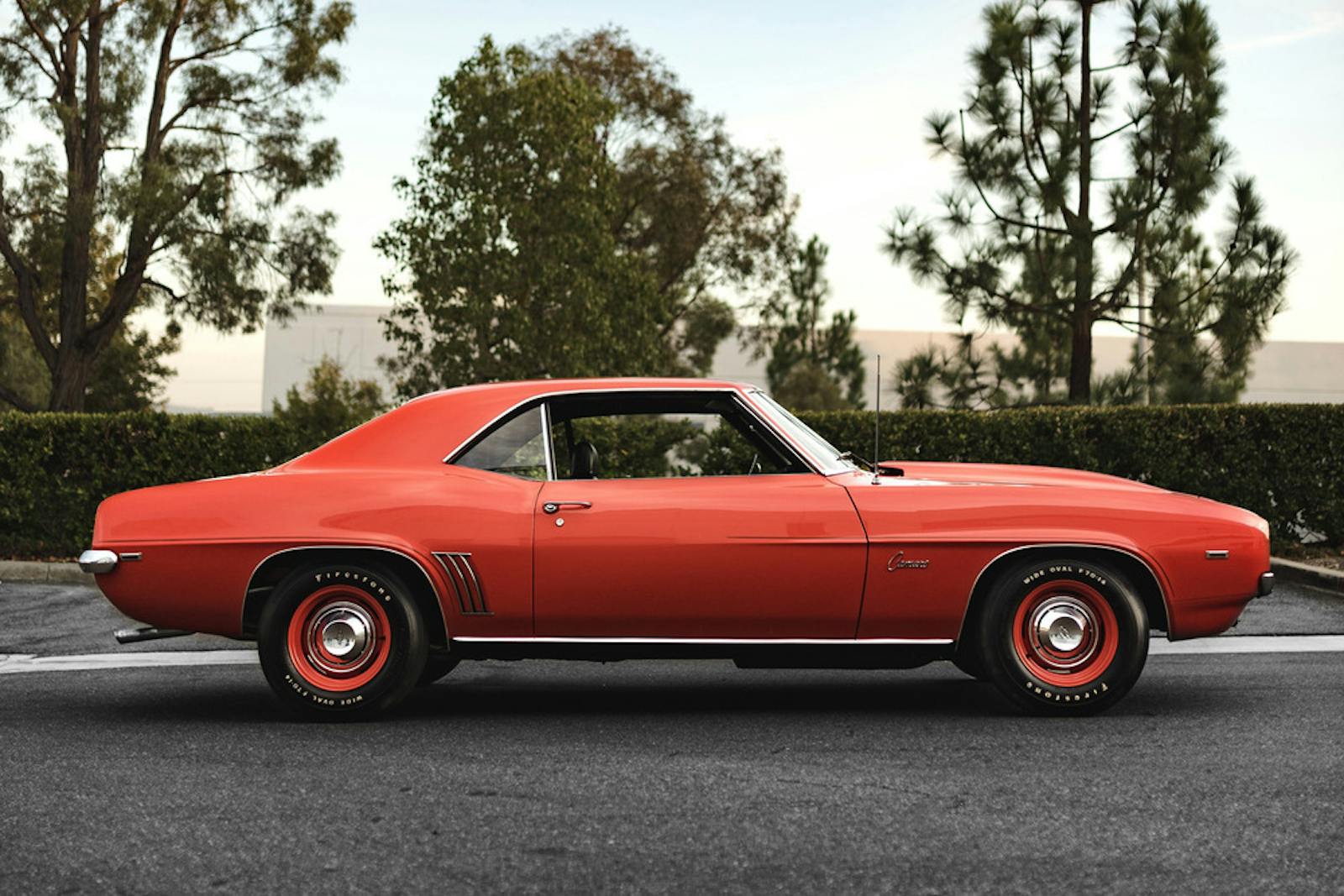In the Moment: Just keep swimming
Welcome to a new weekly feature we’re calling In the Moment!
This all started in Slack, the messaging software we use for staff communication. Several weeks ago, Hagerty’s editor-at-large, Sam Smith, began kicking off our mornings by plopping a random archive photo into the main chat room.
In addition to being a lifelong student of automotive and racing history, Smith drinks a lot of coffee. Each photo he dropped into the conversation was accompanied by a few paragraphs of caffeine-fueled explanation.
We liked these drops a lot, so we’re sharing one here each Thursday. Enjoy, and let us know what you think in the comments! —Ed.
**
Formula 1, Silverstone, 1956. Silverstone is an English track, the home of the British Grand Prix. It is also on the site of an old airfield, an RAF bomber station active from 1943 to 1946. The track surface began life as the perimeter roads and taxiways of that airfield. This was a common thing after the war, especially in England, where decommissioned air bases littered the country.
The man at the wheel, though! And those tires! That’s why we’re here.

This is Juan Manuel Fangio. He is driving a Ferrari-Lancia D50. The car was designed by an Italian-Hungarian named Vittorio Jano. Jano’s engine designs helped Alfa Romeo dominate grand-prix racing between the wars, and his work helped give birth to Ferrari’s legendary “Dino” V-6. The dude is as important as Italian automotive engineers get.
Jano drew up the D50 while working for Italian carmaker Lancia. Neat company, if you aren’t familiar. Lancia gave the world the first production five-speed gearbox, the first production V-4, and the first production V-6. It also produced machines like the Fulvia and the Aurelia, which you should probably google right now simply because they are each understated and gorgeous.
Lancia specialized in a certain kind of distinctly Italian elegance in engineering, and the D50 was no exception. The car was introduced in 1954, chock with innovation: The engine, a 2.5-liter V-8, was a stressed part of the Lancia’s tube frame. It also sat offset—canted at an 8-degree angle—from the D50’s centerline, which allowed it to be mounted lower in that frame. The gearbox, a five-speed transaxle, lived behind the driver, which let him sit lower.

Still, the panniers are the cool part. Note the big blister of bodywork on each side of the car. Those are fuel tanks. At the time, F1 cars were front-engined, with fuel tank in the rear, behind the driver. It worked for packaging, but it also put a significant amount of changeable weight over or behind the rear axle.
Short version: Race carries on, car uses fuel, car’s weight changes as fuel tank empties. More important, weight distribution shifts. A full tank places a much larger percentage of the machine’s total mass out back. Handling balance would shift over time, sometimes drastically.
The D50’s tanks were genius. First, they served to fill the air “hole” between the front and rear wheels. Left untreated and unchecked, this hole is an aerodynamic handicap. It produces drag, promotes instability, sends air into a tizzy. Modern F1 cars must also run their wheels without fenders and so fix the problem with induced vortices. Wings and other body elements are utilized to build relatively stationary masses of air between the wheels, so the incoming air “sees” a solid space. (I learned more about this a while back in this interview with an aerospace engineer. It’s fascinating.)
Second, there was that change in weight carry. The D50 was more balanced than the average F1 car of the period. In race cars, balance is everything. It impacts handling characteristics but also tire use, driver fatigue, even acceleration and braking. Those tanks were heavy and put weight outboard and relatively high, where a race car does not like weight. It didn’t matter; the benefits were worth it.

The D50’s first race came in 1954, at the Spanish Grand Prix. The last points event of the year. The Lancia was brand-new. Even the idea behind it was new. Hell, for that matter, Lancia had never before entered a grand prix. They just hired Jano, trusted him, asked him to look forward, let him run with it.
The car landed pole. Then fastest race lap.
Then, of course, it broke. But that debut!
Maybe this isn’t impressive! Maybe you are looking at this spindly old thing of aluminum and skinny tires and thinking, Well, sure, who cares, slow old car, dead guy at the wheel!
Fair. Seventy years back is a long time. A brief digression for perspective: We are talking here about a 1300-pound device made of small metal tubes and propelled by 260 horsepower, or 285 in later trim. No seatbelt or safety equipment of any kind. Top speed was more than 185 mph. The tall, narrow tires were rock-hard by modern standards. Each offered a contact patch the size of a few postage stamps.
The driver wore something like street clothes. Helmets were cork-lined. Often an old polo hat.
On that note, let’s return to the man in the goggles.

Juan Manuel Fangio was a king in this era, one of the people who figured out modern driving before anyone else. The Argentinian is widely agreed to be the most evolved driver of his era—dominant in sports cars and formula cars, in sedans, in all weather. Always calm and relaxed.
When the D50 launched, in 1954, Fangio was a factory driver at Mercedes. Big company, huge budget, lots of success. In 1955, however, the brand withdrew from motorsport. The reason is both tragedy and story for another day. Lancia, for its part, had issues. The Italian company’s production cars were expensive and slow-selling; its Formula 1 efforts had helped drive the marque toward bankruptcy. The Lancia team was shuttered, the cars and related technology put up for sale.
The deal that followed involved—this is such a great list—an Italian prince, the Italian national automobile club, and the family that owned Fiat. Promises were made. Much noise was made about keeping Italy’s treasures at home. The D50s and their technology were given to Ferrari. Fiat agreed to pay the latter 250 million lira over five years.
Ferrari then was not Ferrari now. The marque was young and struggling, and its racing cars were in a fallow period. The D50s and that funding helped set the company on a greater path. More immediately, with Mercedes out of the picture for 1956, Fangio was no longer employed.

Ferrari hired him. The ’56 F1 season held eight points races. Half of them were won by a D50. Three of those wins came in Fangio’s hands. The man also notched pole in six of those races and fastest lap in four of them. Most of all, he won the championship.
The second-place driver that year was British legend Stirling Moss. The friendship between the two is a cool piece of trivia. Moss and Fangio had been teammates at Mercedes and carried huge respect for each other. Moss was one of the best drivers in the world, massively versatile and fast in anything. And yet he believed, until the day he died, that Fangio was better. Quicker, cleaner, smoother.
Fangio was so good, Moss once said, that the older man could lead him around in equal cars, clear speed in reserve, while Moss was driving as fast as he could. How could the Brit tell? Fangio, he said, occasionally took time for what Moss called “lessons.” When the two men drove together, one following the other, the Argentinian would occasionally vary his corner inputs and lines.
At first, Moss assumed the great man was ill or beside himself. Making stupid mistakes. After a bit, though, he realized the changes were on purpose. Fangio was offering a gentle education in driving technique, a series of subtle lessons in the finer points.
Neat, right? Except: This whole scene, Moss noted, more than once played out while Fangio was leading an active F1 race.
Once Moss caught on, he was flabbergasted. More important, he loved the gesture.

The slide in this picture is not dramatic, just a light bit of yaw. Fangio was a master of small inputs. He was also a master when it came to putting a period treaded crossply tire in its sweet spot of slip angle.
Treated properly, tires like this don’t really slow the car when they slide. The details hang on tire compound and construction, but a cornering crossply is typically fastest when it feels slightly less than planted. The result is something like that smudgy forward-outward-tangent feel you get when cornering on roller skates.
Modern tires are radials, and radials are different. Driving a modern car quickly is like scribing a line with a wobbly hand. A small amount of slip is generally necessary; too much, the rubber molecules and tire carcass get into a kind of fight with the pavement. They grab and slow and bind and release, over and over. Lap times rise.

A more obvious but equally cool note: Look where Fangio’s head is turned. He’s looking through the corner.
Now click the image, zoom in, look where his eyes are aimed. Even further to the right. You can basically use that angle to judge the width and length of the corner, even though we can’t see the exit.
Lesson for the day? It’s a two-parter. First: Trust your people. Believe in them, let them take chances, remember Jano.
Second: The car goes where you look. Always. So keep your head up.
Yes, that’s a metaphor.
Have a good day, guys!
—Sam


